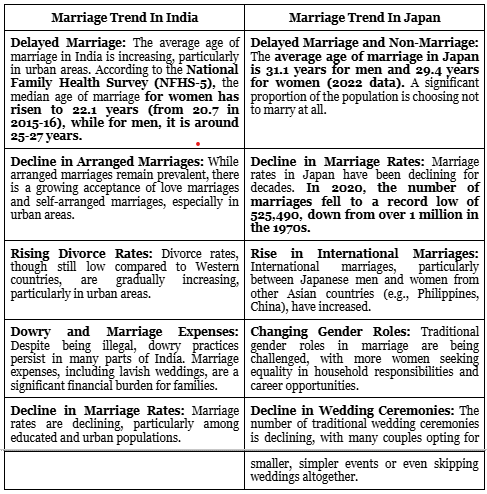Font size:
Print
China’s Marriage Rates Hit Record Low
Context: Despite numerous government initiatives, China witnessed a historic decline in marriages last year, with the number of couples tying the knot falling by 20%, marking the sharpest drop on record.
Why Are Fewer Chinese Couples Getting Married?
- High Cost of Living and Childcare: The rising cost of raising children, particularly childcare and education, has discouraged many young couples from starting families.
- Economic Uncertainty: China’s slowing economic growth and job market instability have made it difficult for university graduates to find stable employment.
- Many who do secure jobs remain uncertain about their long-term financial prospects, leading them to delay or avoid marriage altogether.
- Changing Social Norms: Urbanisation and evolving attitudes towards marriage and family life have also played a role, with younger generations placing greater emphasis on personal freedom and career ambitions over traditional family structures.

Numbers Behind the Trend
- In 2023, only 6.1 million couples registered for marriage, a significant drop from 7.68 million in 2022.
- This marks a decline of more than 50% from 2013, when 13.47 million marriages were recorded.
- In contrast, divorces increased slightly, with 2.6 million couples filing for separation, up 1.1% from the previous year.
- According to Yi Fuxian, a demographer at the University of Wisconsin-Madison, this steep decline could threaten China’s long-term political and economic ambitions, as the country struggles with a rapidly aging population.
China’s Aging Population Crisis
- With a population of 1.4 billion, China remains the world’s second-most populous country, but its demographic structure is shifting rapidly:
- The country’s birth rate has declined for decades, influenced by the one-child policy (1980-2015) and rapid urbanization.
- Over the next decade, approximately 300 million Chinese citizens—nearly the size of the U.S. population—will enter retirement, increasing the economic burden on the younger workforce.
- Although birth rates saw a slight increase in 2024—partly due to the traditional belief that babies born in the Year of the Dragon will have prosperous futures—the overall population has continued to shrink for the third consecutive year.
Government Efforts to Reverse the Trend
- Love Education: Introducing “Love Education” in colleges and universities to promote positive attitudes toward marriage, relationships, and family life.
- Allocation of Resources: Encouraging local governments to allocate resources toward tackling the population crisis and fostering greater societal respect for childbearing and marriage at the right age.
- Incentives: Providing financial incentives and improving social policies to make raising children more affordable.
While government initiatives aim to boost interest in marriage and childbirth, deep-rooted economic pressures and shifting social values continue to shape young people’s choices. Without significant improvements in economic stability, job security, and family support systems, the downward trend in marriage rates may persist—posing long-term challenges for China’s workforce, economy, and demographic future.

